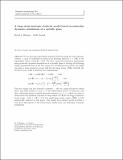A Large Strain Isotropic Elasticity Model Based on Molecular Dynamics Simulations of a Metallic Glass
Author(s)
Henann, David Lee; Anand, Lallit
DownloadNonLinearElasticJElast_revised_v3.pdf (493.5Kb)
OPEN_ACCESS_POLICY
Open Access Policy
Creative Commons Attribution-Noncommercial-Share Alike
Terms of use
Metadata
Show full item recordAbstract
For an isotropic hyperelastic material, the free energy per unit reference
volume, ψ [psi], may be expressed in terms of an isotropic function ψ = ¯ ψ(E) [psi = psi overscore (E)] of the
logarithmic elastic strain E = ln V. We have conducted numerical experiments
using molecular dynamics simulations of a metallic glass to develop the following
simple specialized form of the free energy for circumstances in which one might
encounter a large volumetric strain trE, but the shear strain √2|E0| [square root 2 pipe E subscript 0 pipe] (with E0 [E supscript 0] the
deviatoric part of E) is small but not infinitesimal:
ψ(E) = μ(trE) |E0|2 [psi (E)= mu (trE pipe E subscript 0 pipe superscript 2] + g(trE) , with
μ(trE) = μr − (μr − μ0) exp„trE
ǫr « [mu (trE) = mu subscript x - (mu subscript x - mu subscript 0) exp (trE divided by epsilon subscript x)], and
g(trE) = κ0 (ǫc)2 »1 − „1 +
trE
ǫc «exp„−
trE
ǫc «– [g(trE) = kappa subscript 0 (epsilon subscript c) superscript 2 [1-(1 + trE divided by epsilon subscript c) exp (-trE divided by epsilon subscript c)]].
This free energy has five material constants — the two classical positive-valued
shear and bulk moduli μ0 [mu subscript 0] and κ0 [kappa subscript 0] of the infinitesimal theory of elasticity, and
three additional positive-valued material constants (μr, ǫr, ǫc) [(mu subscript r, epsilon subscript r, epsilon subscript c)], which are used to
characterize the nonlinear response at large values of trE. In the large volumetric
strain range −0.30 ≤ trE ≤ 0.15 but small shear strain range √2|E0| [square root 2 pipe E subscript 0 pipe < or about] 0.05
numerically explored in this paper, this simple five-constant model provides a
very good description of the stress-strain results from our molecular dynamics
simulations.
D. L.
Date issued
2011-08Department
Massachusetts Institute of Technology. Department of Mechanical EngineeringJournal
Journal of Elasticity
Publisher
Springer
Citation
Henann, David L., and Lallit Anand. “A Large Strain Isotropic Elasticity Model Based on Molecular Dynamics Simulations of a Metallic Glass.” Journal of Elasticity 104.1-2 (2011) : 281-302. Copyright © 2011, Springer Science+Business Media B.V.
Version: Author's final manuscript
ISSN
0374-3535
1573-2681